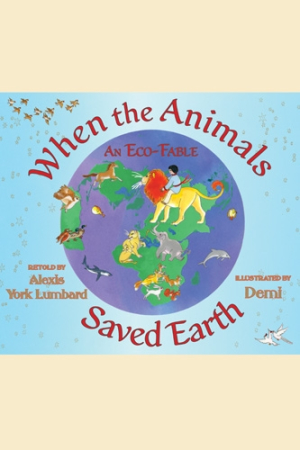When the Animals Saved Earth
An Eco-Fable
When the Animals Saved Earth appeals to a child’s natural sense of justice and is a vivid reminder to preserve rather than destroy.
Alexis York Lumbard portrays greed, animal cruelty, and a king’s call for compassion in this pointed retelling of a story from Iraq. When the Animals Saved Earth: An Eco-Fable features mixed media illustrations by award-winning Demi, of The Empty Pot fame, who captures visceral moments with her signature chinoiserie. Here, a few of civilization’s consequences speak to modern times; the story’s end offers hope for restoring peace.
The plot begins with a portrait of an uninhabited Emerald Isle, which is soon colonized by shipwrecked humans. With the exception of a young boy, Adam, they set about building—a task that fans the desire for greater resources and animal slaughter. A heartbroken Adam becomes an intermediary who befriends the island’s animals. Together, they approach King Bersaf, “a Spirit King, made of fire and air,” whose counsel leads to a meeting with the humans. When the king takes the animals’ pain and transfers it to the humans, he sets the stage for a newly healed earth.
For children, the brief inclusion of problems such as deforestation, pollution, and poisoned waters serve as caution against hubris. Adults may find the portrayal of human progress at the expense of the earth unsubtle. Divine intervention as a solution for Emerald Isle’s problems may seem like an easy way to wind the plot. The suggestion that humans could not otherwise change also strikes a potentially cynical note. Considering the work’s ancient origins, however, such religious undertones aren’t surprising. They are entirely in keeping with the overall message of good stewardship.
The story’s concise, alliterative expressions make reading aloud a pleasure. Such lines include “Here the winged and webbed, hoofed and horned, mighty and meek, all lived in peace.” When rhymes are used in the king’s dialogue—“This case against the humans / Is rather plain and clear. / They are guilty of spreading / Destruction, wrong, and fear”—the resulting music seems less organic.
Demi’s sumptuous textiles, colorful compositions, and miniature figures lend battle scenes as well as encounters with the king a tapestry-like quality. Little is held back—scenes depict the bloodiness of butchery, animal whipping, shackling, and overcrowding in cages. Backgrounds that employ simple gradients appear hastier than those that feature mountainous landscapes, careful cloud patterns, and in one beautiful instance, marbleized paper to represent ocean waves.
With its earnest approach, When the Animals Saved Earth is a vivid reminder to preserve rather than destroy. The book appeals to a child’s natural sense of justice and is a fitting introduction to the Wisdom Tales imprint.
Reviewed by
Karen Rigby
Disclosure: This article is not an endorsement, but a review. The publisher of this book provided free copies of the book and paid a small fee to have their book reviewed by a professional reviewer. Foreword Reviews and Clarion Reviews make no guarantee that the publisher will receive a positive review. Foreword Magazine, Inc. is disclosing this in accordance with the Federal Trade Commission’s 16 CFR, Part 255.

